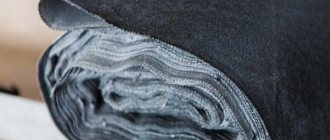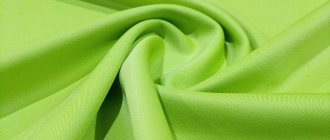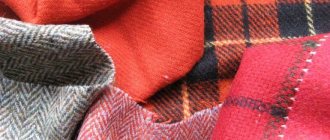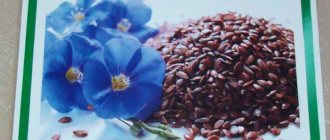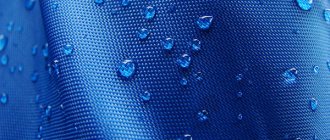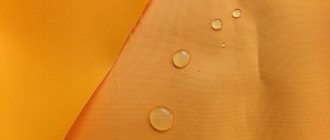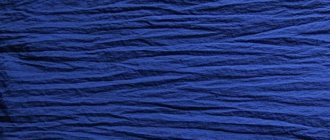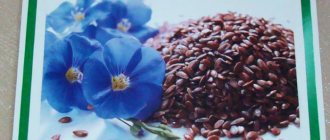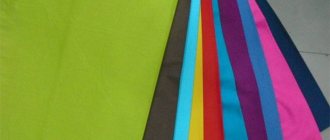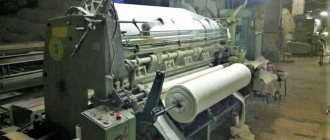Devore is an amazing decorative fabric whose pattern and texture resembles stained glass. The peculiarity is that this is more of a decorative technique for finished fabric, and not some special fabric with a special weave of threads and a complex history.
Devore material can be transparent, translucent and matte. A velvet or satin pattern seems voluminous, floating above an airy field. The special texture of the fabric is obtained by chemical etching. The material is used to create clothing and elegant home textiles.
A little history
The once unique technology of chemical etching, in which devoré fabric takes on a sophisticated, elegant look, is now used by many manufacturers and is becoming popular, but many still do not know what it is.
Devore first became known at the end of the 19th century, when a beautiful material similar to lace fabric began to be created in factories in the French city of Lyon. The material created in this way was considered exquisite and expensive at that time; it was made on the basis of velvet and silk; festive outfits were sewn from it for royalty and rich people. The advent of synthetic fiber gave this technique a rebirth.
The idea of using devoré on fabrics woven from artificial threads turned out to be so successful that a new technological production based on various materials was developed. Now there is a large selection of original fabrics with an “etched” surface, various textures and colors at a very affordable price.
Fabulous interior
Devora organza takes its rightful place in the extensive family of curtain fabrics. The amazing effect of floral, animalistic or other ornaments floating in the air makes any interior elegant and sophisticated. A variety of colors and patterns will allow you to choose curtains for a cheerful children's room, a cozy bedroom, or an elegant living room to suit every taste and budget. Organza with etched patterns is suitable for any type of sheer curtain. It looks especially stylish and original in Japanese panels - smooth curtains on sliding slats with weights at the bottom, allowing you to create the effect of temporary stained glass. An exclusive decoration of the home will be decorative panels, capes and other home textiles made from natural materials according to the author’s sketches.
An original direction for using the technique of artistic fabric etching is bed linen made of satin devore. These sleeping sets:
- retain all the advantages of products made from natural cotton, first of all, high hygienic properties;
- durable;
- easy to care for;
- very beautiful and elegant, they surpass in their aesthetic properties and variety even the currently popular bed linen with three-dimensional photo prints.
Satin devore is an expensive fabric and rarely appears on the domestic market . Nevertheless, such a sleeping set will be a worthy competitor to exclusive bed linen made of silk and other materials.
Production Features
Devore is a complex chemical etching technique that gives fabric a magnificent, truly magical look. An exquisite satin or velvet design literally floats on a matte or transparent background, and the material becomes light, vibrant and voluminous.
As mentioned above, devore is a fabric with a special surface texture obtained by chemically burning out part of the fibers. When devore was made only from silk (smooth or fleecy, velvet). Modern fabrics contain mainly polyester and viscose. As a result, the material has become significantly cheaper, but has not lost its main highlight - its original and attractive appearance. The more expensive Devore is made from natural (cotton and linen) and mixed fibers. But the most expensive and in demand fabric is still considered to be one based on natural silk.
The photo shows chiffon made using etching technology,
Organza Devore is one of the most popular curtain fabrics.
Today, most modern devoré materials are organza, consisting of 70% polyester (warp thread) and 30% viscose (weft thread).
The essence of the etching technique is that individual sections of the finished fabric are burned out with specially selected chemical reagents, resulting in a fabric with alternating dense and transparent sections.
Devore production consists of the following stages:
- A specially prepared sketch is applied to the canvas.
- A protective compound is applied to the backside to etch out areas strictly according to the sketch, but not to damage the rest of the material.
- Then the etching procedure is carried out. Under the influence of chemicals, the selected layers are destroyed and the desired pattern is formed. Reagents are selected for each material separately.
- The canvas is washed in a soda solution, all chemicals are removed.
- After etching, additional designs can be applied to the canvas.
Devore technology is considered environmentally friendly, since the soda solution neutralizes all harmful components and makes the fabric safe for health.
The etching process itself comes in three types:
- Liquid (burning with chemical reagents).
- Electromechanical (an electric field is applied to the canvas).
- Dry (ion plasma).
Fabrics of any texture and fiber composition - satin, silk, velvet, velor, chiffon, organza - can be etched.
Depending on the artistic intent, the canvas can be painted in different colors and have a variety of prints. One of the most exquisite methods of decoration is hand painting.
Advantages and disadvantages
Despite the fact that things made from devore look fragile, it is a very durable and practical material that has a lot of advantages:
- it is wear-resistant and durable;
- tear resistant;
- does not fade in the sun;
- absorbs moisture well and dries quickly;
- the ability to retain heat depends on the original material;
- allows the body to breathe;
- usually does not cause irritation or allergic reactions;
- easy to use and maintain.
There is, perhaps, only one drawback - the high price.
Benefits of Devore fabrics
Devore silk is one of the most expensive and exclusive natural materials.
Etched silk fabric.
Using this technology, curtain fabrics of various compositions are produced.
Devore velvet looks incredibly luxurious and mesmerizing.
Since Devore is not inherently a type of fabric, but a special type of surface on a certain type of fabric, each of them has the advantages of its own “family”, to which is added an unusual surface texture.
Devore, based on viscose and polyester, belonging to the tulle fabric family, has the following advantages:
- UV resistance (does not fade in the sun);
- strength and wear resistance (last for many years);
- easy care (easy to wash and dry quickly).
Devore based on natural (silk, cotton and linen) fibers retain all the advantages of natural materials:
- hygroscopicity (they absorb and evaporate moisture well);
- hygiene (“breathe” and do not interfere with free heat exchange).
Kinds
“Devore” is relevant for different canvases, each with an individual design.
The technique is combined with the following fabric:
- organza - a thin transparent material used for sewing tulle;
- panvelvet - the king of canvases, combining sophistication and fabulousness of products;
- voile devore - a spectacular tulle fabric that makes light curtains;
- silk - the most expensive option, incorporating subtlety, elegance, and tenderness.
- chiffon - a delicate, airy, truly feminine fabric.
Various materials are processed. Does not etch – wool. The color palette includes black, white and bright shades. A printed pattern or print on organza looks beautiful.
Areas of use
Despite the fact that such materials look thin and delicate, etching gives them strength and allows them to be successfully used for sewing beautiful, wear-resistant clothing and home textiles (curtains, bedspreads, pillows).
The main areas of application of Devore fabrics are sewing elegant clothes and designer curtains for decorating luxury interiors.
Women's clothing is mainly made from fabric with an etched surface, mainly wedding, cocktail and evening dresses, skirts, blouses and cardigans. All Devore items are light and airy, do not restrict movement, and successfully emphasize the dignity of the figure.
Designers prefer to sew models from devore with a distinctly simple cut, so as not to distract attention from the exquisite pattern on the fabric.
It is impossible to take your eyes off evening dresses made using the devoré technique.
It is practically not used for sewing men's clothing. The exception is the concert costumes of pop stars and circus performers.
Tulle and devore curtains seem to be specially created for luxurious interiors, decorated in the classic styles of past centuries.
The technique of making devoré fabric is successfully used in the production of tulle. Graceful floral patterns and elegant arabesques look perfect on a transparent base. The ability to choose tulle with different patterns, differing in shape and color, makes it truly versatile. Such curtains add airiness and lightness to the interior, filling its atmosphere with soft natural light, as if sifted through an invisible sieve. They fit best in luxurious or romantic styles, such as:
- baroque;
- rococo;
- Empire;
- Provence;
- Mediterranean;
- Scandinavian;
- and the like.
The textile industry produces curtains in the form of original tulle or curtain mesh with various patterns, organza using the devoré technique, nylon with a multi-colored pattern, transparent cambric with a woven pattern.
Bed linen made from devore satin is considered elite.
Such sleeping sets are just conquering the market, but have already become very popular.
A special area of using the technique of artistic fabric etching was the production of bed linen from devore satin. Such sleeping sets have all the advantages of natural cotton products, they are durable, hygienic, easy to care for and at the same time exquisitely beautiful. Today they outsell even the trend of recent years - duvet covers and pillowcases with 3D printing.
In addition, decorative panels, napkins, capes and other elegant home textiles for exclusive interior decoration are becoming increasingly popular.
Customer Reviews
Lyudmila “The evening dress, decorated with an elegant and graceful pattern, is simply a delight! A true miracle of the textile industry, soft and light, elegant. I would especially like to note the durability and ease of care, just wash it and you can put it on again!”
Tatyana “If there is a minus, it’s the cost; such things are quite expensive. Otherwise, dresses and blouses like these are incredible. Soft, airy, decorated with exquisite design. It is very important for me that the fabric does not cause allergies, it is worn in summer and winter - it is neither hot nor cold.”
We will tell you how to remove wax from clothes in another review.
How to care
Despite the external thinness and fragility, the products are easy to care for. It is recommended to look at the label for the specific material for detailed care instructions:
- It is better to wash Devore clothes by hand, after a short soaking;
- bulky home textiles (curtains, bedspreads, tablecloths) can be machine washed;
- when washing automatically, the delicate mode is usually selected and the water temperature is 30-40°C;
- washed items are carefully straightened out and dried away from heating devices (items on hangers, tulle directly on the curtain rod);
- It is preferable to iron any products from the wrong side in a mode appropriate to the type of fabric.
Delicate and exclusive items (very thin or with hand embroidery, sequins) are best taken to a professional dry cleaner.
Subtleties of care
Products made from devoré style knitwear can be maintained at home.
Preservation of aesthetic qualities and attractive appearance ensures:
- delicate wash at 30 degrees;
- ironing from the wrong side, or through a napkin;
- drying the washed item unfolded, preferably in the shade.
Velvet material requires special conditions:
- washing is preceded by dry cleaning;
- any product cannot be machine washed;
- using mild detergents for delicate fabrics;
- Thorough rinsing to get rid of stains;
- velvet’s best friend is a steamer or steam generator (temperature should not exceed 100 degrees).
Advice: a product made of velvet made using the devoré technique is prohibited from squeezing, twisting, or rubbing. Drying requires a horizontal position.
Delicate items of clothing, such as hand-painted items, are recommended to be dry cleaned.
Royal outfits
The first mentions of this luxurious material date back to the end of the century before last. It was created at the famous silk factories of Lyon with the aim of creating a not too labor-intensive imitation of lace fabric. Exquisite fabric was used to make ceremonial dresses for royalty and very wealthy people. The Art Nouveau era, with its ideal of a refined female appearance and flowing dresses, caused a surge of interest in devor, although, of course, not everyone could afford such silk or velvet fabric. Nevertheless, secular fashionistas wore translucent evening dresses with exquisite textured ornaments and patterned stoles until the 30s.
The appearance of viscose and synthetic fibers literally gave a rebirth to this material. Patterned fabric became more affordable, and in the early eighties of the last century it began to be widely used for elegant dresses and blouses, capes, stoles, etc. Currently, it can be argued that such outfits actually do not go out of fashion. The current trend towards transparency makes devoré, especially on a synthetic basis, more and more in demand, primarily for elegant light dresses, transparent blouses, etc. Natural coupon materials are used for exclusive clothing; the originality of their ornaments implies a laconic cut and a minimum number of seams.
